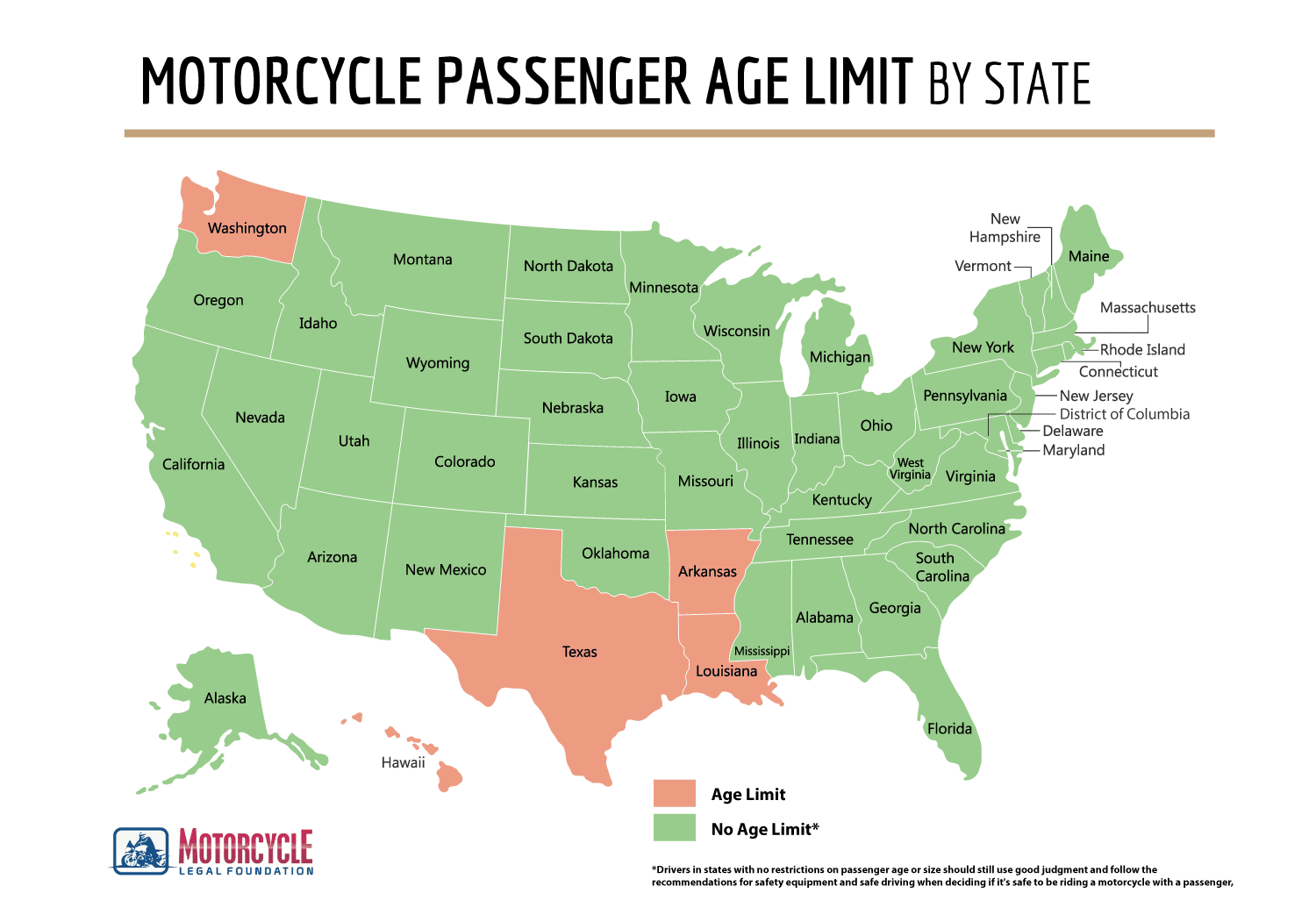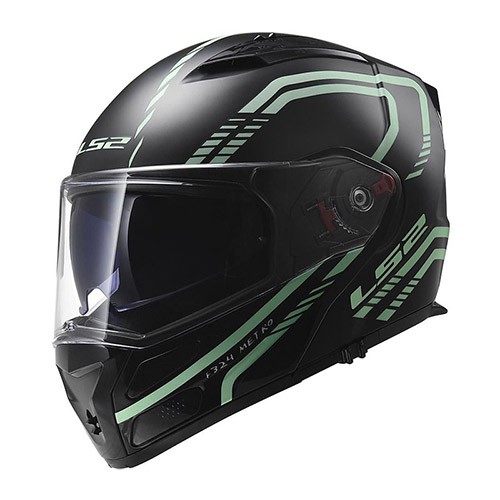As a motorcycle rider and enthusiast, it’s only natural for you to share your love of riding with your children. Of course, safety is your primary concern, so getting them the proper headgear and eye protection goes without saying. However, before letting a child ride along with you as a passenger, you need to know what the minimum age for motorcycle passengers is in your state.
It may come as a surprise, as it did for us, that only a handful of states enacted laws to set a minimum legal age for a child to ride as a passenger on a motorcycle. Unless the child is at least five years old, riding with your son, daughter, or grandchild as a passenger is illegal in Texas and Washington, but you could take them along with you without violating the law in South Carolina as long as the motorcycle is equipped with a seat designed for two people or has a second seat permanently attached for the passenger.
California motorcycle riders need to be more concerned about the height of a child than their age. A child may ride as a passenger provided their feet rest comfortably on the footrests when seated in a passenger seat permanently affixed to the vehicle.
Wherever you live or ride, the safety of a child should be your paramount concern. Motorcycles lack the stability of cars and trucks, and they certainly do not provide riders with the same level of protection that occupants of other types of motor vehicles have in a crash. Motorcyclists have a much higher rate of deaths in collisions at 59.49 per 100,000 registered vehicles as opposed to cars with 15.06 fatalities per 100,000 registered vehicles in the country.
With the safety of your child in mind, let’s take a look at legal restrictions on the age of motorcycle passengers along with information about safety gear and equipment that help ensure that you and your passengers have an enjoyable and safe ride together.
How Old Should a Child Be to Ride on the Back of a Motorcycle?
Each state has its own laws pertaining to the operation of motorcycles. Whether you reside in the state and travel locally or happen to be passing through during a road trip, you need to be aware of and obey the laws of each state where your travels take you.
Following are the laws governing passengers on motorcycles, including minimum age requirements, for each state:

Alabama
To carry a passenger, a motorcycle must have footrests, a permanently affixed seat, and a strap or handhold for passengers to hold while riding. No age minimum exists, but passengers must wear a helmet and proper footwear.
Alaska
A passenger must wear a helmet, be seated in a permanently installed passenger seat, have footrests available, but there are no minimum age laws.
Arizona
The state requires that motorcycles be properly equipped to carry passengers, which includes separate seats and footrests. Passengers under 18 years old must wear a helmet. No minimum age restriction exists for passengers, but riders must have a license and not a learner’s permit to carry a passenger.
Arkansas
Passengers must be at least eight years of age.
California
The state does not have a minimum age requirement, but it has what amounts to a height requirement for passengers by requiring that a passenger’s feet must touch the footrests while seated on the motorcycle.
Colorado
No age restrictions exist for passengers, but anyone who is younger than 18 years old must wear a helmet.
Connecticut
Motorcycles must be equipped with a permanently attached seat for the passenger. The state does not set a minimum age for passengers, but riders must be licensed. Newly licensed riders cannot carry passengers for at least 90 days, and riders who got their license before they were 18 must wait six months before riding with a passenger.
Delaware
Motorcycles must have a passenger seat and footrests to carry passengers, but the state does not have a minimum age. Riders and passengers must be in possession of a helmet.
District of Columbia
Washington, D.C. requires a passenger seat and footpegs, but it does not have a minimum age for passengers.
Florida
No age minimum exists for passengers, but anyone younger than 21 must wear a helmet when riding either as an operator or passenger.
Georgia
Motorcycles must have a passenger seat and footrests to carry passengers. There is no age minimum, but riders and passengers must wear helmets.
Hawaii
Motorcycles must have separate seats and footrests for passengers who must be at least 7 years old. Helmets must be worn by anyone younger than 18 years of age.
Idaho
Motorcycles must have a passenger seat and footrests. No minimum age for passengers, but helmets must be worn by anyone younger than 18.
Illinois
Motorcycles designed and equipped for two people may be used to carry a passenger without any restriction on age.
Indiana
Motorcycles must have separate seats and footrests for passengers who can be of any age. Those younger than 18 must wear a helmet.
Iowa
Motorcycles that have separate seats and footrests for them may carry passengers without an age restriction. Helmets are required for anyone younger than 18.
Kansas
Motorcycles equipped to carry passengers may do so without regard to age.
Kentucky
Passenger seats and footrests are required to carry a passenger, but no minimum age requirement exists. Helmets must be worn by anyone younger than 21 years old.
Louisiana
A passenger must be at least five years old to be a passenger. The motorcycle must have a passenger seat, and the child must wear a helmet.
Maine
Passenger seats and footrests are required to carry a passenger, but there is a minimum age. The state has a helmet law for anyone on a motorcycle who is under 18.
Maryland
While the state cautions adults to be mindful of the risks of children riding as passengers, it does not set a minimum age requirement.
Massachusetts
The state does not set a minimum age for passengers.
Michigan
Passengers must be able to reach the footrests when seated; otherwise, there is no age restriction for passengers. The law includes an exemption for passengers who cannot comply because of permanent physical disability.
Minnesota
A passenger seat and footrests must be installed and helmets are worn by anyone under 18, but the state does not have a minimum age for passengers.
Mississippi
No minimum age restriction for passengers exists, but they must wear a helmet.
Missouri
Although there is no age minimum, children should never be seated between two adults.
Montana
A passenger seat and footrests must be installed and children under 18 must wear helmets; otherwise, the state does not set a minimum age for passengers.
Nebraska
No age restrictions exist for passengers.
Nevada
No age restrictions exist for passengers as long as they can reach the foot pegs or footrests and have the ability to hold onto the rider or a handhold.
New Hampshire
A passenger seat and footrests are required, but no minimum age requirement exists for passengers other than the law requiring that riders and passengers younger than 18 wear helmets.
New Jersey
There is no minimum age requirement, but passengers must be able to reach the foot pegs when seated. Only a motorcycle designed and equipped to carry more than one person may carry a passenger.
New Mexico
There is no minimum age requirement for passengers, but only a motorcycle designed and equipped to carry more than one person may carry a passenger.
New York
No one younger than 6 years of age may be a passenger, but there is an exception for motorcycles equipped with sidecars.
North Carolina
There is no minimum age requirement for passengers, but only a motorcycle designed and equipped to carry more than one person may carry a passenger.
North Dakota
The state does not have restrictions on passengers.
Ohio
No minimum age for passengers.
Oklahoma
No minimum age for passengers.
Oregon
A passenger seat and foot pegs are required, but the state does not have a minimum age for passengers.
Pennsylvania
Passenger seats and foot pegs are required, but the state does not have a minimum age for passengers.
Rhode Island
Carrying a passenger younger than 12 years of age requires a seat with a secured backrest, and the child must be able to reach the footrest.
South Carolina
Passenger seat and foot pegs are required, but the state does not have a minimum age for passengers. Riders younger than 21 must wear a helmet.
South Dakota
Passenger seat and foot pegs are required, but the state does not have a minimum age for passengers. It does require a helmet to be worn by riders younger than 18.
Tennessee
Passenger seat and foot pegs are required, but the state does not have a minimum age for passengers.
Texas
Children must be at least five years old to be a passenger.
Utah
Passenger seat and foot pegs are required, but the state does not have a minimum age for passengers.
Vermont
Passenger seats and foot pegs are required, but the state does not have a minimum age for passengers.
Virginia
No minimum age has been established for passengers.
Washington
Children must be at least five years old to be passengers on a motorcycle.
West Virginia
Passenger seats and foot pegs are required, but the state does not have a minimum age for passengers.
Wisconsin
Passenger seat and foot pegs are required, but the state does not have a minimum age for passengers.
Wyoming
Passenger seat and foot pegs are required, but the state does not have a minimum age for passengers.
Check with the states where you intend to ride to make certain that carrying a passenger does not violate their laws.
How to Prepare a Child Before Riding on a Motorcycle
Regardless of what laws say about minimum ages for passengers, riding with a child who cannot comfortably rest both feet on the passenger foot pegs is unsafe. Assuming that your child meets that minimum requirement, here is how to get started:
- Your child needs a helmet that fits properly.
- Check to make certain the child wears shoes or boots and protective eyewear.
- Show the child how to buckle and unbuckle the chinstrap. Emphasize the importance of keeping it buckled while on the motorcycle.
- Correctly position the child on the seat with feet on the pegs. Show the child how to hold you or handholds and stress the importance of holding on throughout the ride.
- Caution the child against making sudden moves while the motorcycle is in motion.
- Remind the child not to attempt to get off the motorcycle until told to do so by you.
- Do a last-minute safety check of the motorcycle before heading off on your ride.
Long pants and long sleeves prevent burns from arms and legs coming into contact with hot surfaces, such as exhaust pipes, so everyone, including passengers, should wear them when riding. They also help reduce injuries particularly during minor accidents or in case you lose balance and drop the motorcycle when stopped at a light.
If the thought of sharing the joy of motorcycle riding by taking a child along as a passenger appeals to you, all it takes is a little time. First, research the minimum age restrictions that may exist, and then, ensure that you, your motorcycle, and your passenger have the right equipment to make it a safe experience.

